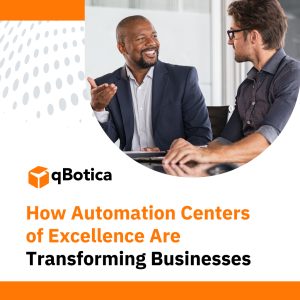Many experts believe artificial intelligence (AI) is phasing out the need for human workforces entirely. But it doesn’t have to be this way. Rather than seeing automation as a threat to all jobs, we see AI as an opportunity to future-proof businesses by making them even more staff-focused. What do we mean by this? Human-centered automation is about using technology to augment employee abilities rather than replace them. This innovative automation approach can reduce costs, improve efficiency, and make businesses more competitive.
Here we’ll discuss the benefits of human-centric automation and how businesses can begin implementation.
What is Human-Centered Automation?
According to Christine M. Mitchell 1996, human-centered automation is “…automation whose objective isn’t necessarily to automate previously manual activities, but rather to improve user efficiency and minimize error.” In other words, human-centered automation is about using technology to make work easier for people, not replacing them altogether.
Human-centered automation streamlines various procedures, such as data collection and verification, through machine learning (ML) technology. This gives staff more time to perform higher-value tasks like exception handling and process improvement.
To effectively implement human-centered automation, businesses must consider how users interact with the system and prioritize staff needs above all else. It’s also essential to ensure that the automation is flexible enough to adapt as people’s needs change. After all, what works today might not work tomorrow, so it’s crucial to adjust over time.
Advantages of Human-Centered Automation
Human-centered automation aims to make users’ lives easier by automating either difficult or time-consuming tasks. It can eliminate inefficiencies, speed up processes, and make operations run more smoothly.
Increased Job Satisfaction
Automating manual procedures allows businesses to give staff members new, more rewarding opportunities. Instead of spending time on rote tasks, like data entry, staff can focus on more client-centered roles. Automation helps reduce backlogs and ease stress levels while enabling more substantive customer interactions and allowing employees to use their whole skill set. This benefits the employee and can lead to a more agile and responsive business.
Fewer Errors
Examples of Human-centered Automation
Quicker Advancements in Healthcare
Healthcare is not only data-intensive–it demands innovative solutions to solve the world’s greatest medical challenges. Human-centered automation has made this possible by optimizing patient, doctor, and practitioner services. For example, AI-basedsoftware can analyze vast swathes of healthcare data, such as pictures, clinical research trials, and medical claims. With that information, it can detect patterns and offers insights that help experts optimizetreatment protocols, improve patient outcomes, and discover new drug applications.
More Efficient Green Energy
Smart Call Centers
For a long time, humans were responsible for all call center operations. They relied on well-written scripts to perform their jobs and received performance scores based on how quickly and efficiently they resolved customer issues. However, AI has completely transformed call centers into a collaborative environment between humans and machines.
Unlock the Power of Human-Centered Automation with Disqover
The relationship between humans and AI is critical to the future of business success. That’s why strategic organizations must work with automation partners to discover which tasks are fit for humans and which can best be automated through the latest innovations. The best way to begin is by implementing a process discovery tool like Disqover from qBotica. With process discovery, businesses can map out every essential workflow, identifying how to optimize their workforce while maximizing AI opportunities.




